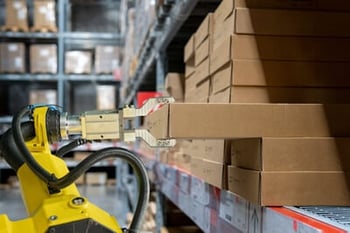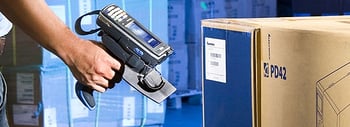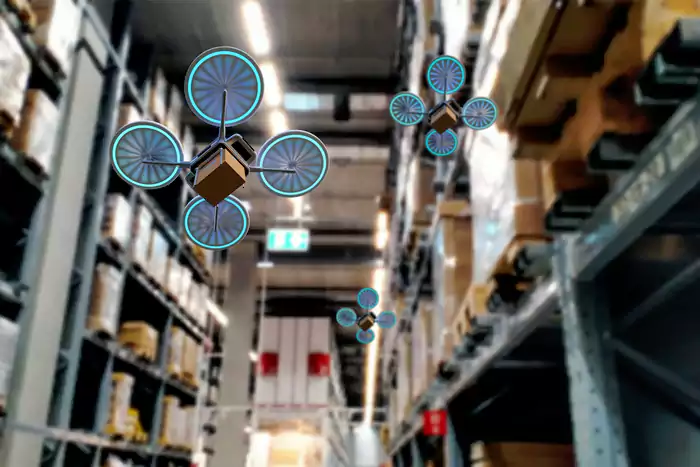There’s a common misconception that warehouses operate in an endless loop of basic processes that move items from point A to point B. Sure, things get moved. But the supply chain is increasingly faced with labor shortages, pandemic issues, and rapidly changing market conditions, making the warehousing environment more complex than ever.
Today’s modern warehouses have evolved thanks to a host of warehouse artificial intelligence solutions. These tools are helping companies meet the demands of always-on eCommerce, the need to manage a massive number of SKUs with fewer errors, and the drive for faster response times. Looking back over the past several years and forward over several more, here is how artificial intelligence is disrupting warehouse operations.
What is Artificial Intelligence?

If a machine can independently gather knowledge to learn from experiences and then act based on those experiences, this is considered artificial intelligence (AI). Similar to a human, these machines can process new information and adapt to changing situations.
AI incorporated into a piece of equipment or machinery is the most sophisticated system available. The traditional approach is to give a computer or piece of machinery instructions that may have to be broken down into smaller operations. With neural networks, the system doesn’t need this input. Instead, it learns what to do and can even solve problems without help.
Machine learning is often used interchangeably with AI. But it’s instead a subset with the ultimate objective of learning to perform a particular task well through the creation of self-learning algorithms and data analysis.
Why a Warehouse Needs Artificial Intelligence
There’s no doubt that AI is a transformative technology. But it would be a mistake to think that AI’s benefits are limited to blue-chip companies and global tech giants. Ultimately, AI will transform every business, in every industry.
If you aren’t using AI in your warehouse, it might be time to give it a closer look. Here are some of the ways artificial intelligence can improve your operations in the short and long term:

- Better communication – Warehouses rely on a constant stream of data. But the human factor can create inefficiencies and costly mistakes. AI can eliminate these inaccuracies and guarantee accurate data on-demand.
- Improved productivity – There will always be a need for human labor, but warehouse automation robots can be more effective at some tasks, with faster and more accurate results.
- Better data – You can ditch the spreadsheets and complicated formulas. AI’s algorithmic analysis will help your organization understand its current situation, recognize patterns, and make better strategic plans.
- Safer workplace – AI solutions can constantly monitor a warehouse environment and its operations. They can analyze activities and assess a risk score to them. Robots can take over the high-risk work, and safer tasks are saved for humans.
- Simpler inventory management – AI can help your warehouse gauge market conditions so that you have the best control over your inventory.
- Lower costs – Embracing AI solutions can help your business lower costs by creating efficiencies and saving on warehouse overhead.
- More effective contingency planning – If the past year and a half has taught us anything, it’s that just about anything is possible. Warehouses regularly face challenges that couldn’t have been predicted without the use of powerful systems. AI helps businesses elevate their level of preparedness for various contingencies by forecasting patterns and allowing organizations to manage their inventory and operations during changing times.
3 Ways Artificial Intelligence is Changing Warehouse Operations
Imagine stepping back in time to visit a large warehousing operation in the 1980s or 1990s. If you could, it would put today’s warehouse technological advances into sharp focus. Now imagine what a warehouse might look like in 2050 or beyond. Probably much different than today.
Mentioning AI in some warehouses might get you strange looks. But many workers and even managers aren’t aware that they’re already using some AI solutions. And, even if they aren’t, their competitors probably are. Here are just three ways AI is re-shaping warehouse operations today:
1. Automated Vehicles
Automated vehicles are replacing human-driven ones like forklifts in the warehouse. Small carts that come equipped with 3PL systems or warehouse management software are one example. Smart trucks that can help with parcel management or surveillance are another.
While we’re still a few years away from autonomous delivery trucks, they remain in the testing stages. Typically, the most difficult and costly part of the supply chain is last-mile deliveries, so this is where you’re likely to see these solutions implemented first. And while drones aren’t being used for deliveries yet, they are being put to work in warehouses and yards for inventory management.
2. Warehouse Automation Robots
Warehouse automation robots can be used to stack and store products in a facility automatically. The picking, stacking, and storing of products can be accomplished by automated machines that place items according to a complex algorithm that considers the ease of access to the product, frequency of purchase, expiration dates, and many other factors.
A host of large retailers and eCommerce giants use warehouse automation robots to drive greater efficiencies and create a better customer experience. Some examples include Amazon, Zappos, Coca-Cola, and Alibaba.
3. RFID Scanners

Radio frequency identification (RFID) is replacing bar code scanners and paper trails for the control and organization of inventory. RFID scanners don’t require a direct line of sight to the product, making it easier to use in a warehouse setting. When combined with AI technology, these smart warehouse systems can adjust the volume and speed of order processing to boost overall productivity.
Automation Boosts Efficiency and AI Creates More Jobs
Chances are, you’ve heard more than a few “the sky is falling” predictions about AI and its implications for the future of the workforce. The machines are coming to take everyone’s jobs. While a scary prospect for sure, it’s fortunately not based in reality. In fact, most major companies are using automation, and the demand for warehouse workers is up over 19% from just two years ago.
What is true is that automation will replace many repetitive jobs. Workers are increasingly dissatisfied with jobs that require them to work in hot, hazardous, and unstimulating conditions. And those very conditions are what can lead to lower productivity, more human errors, costly accidents, and a poor customer experience. Implementing AI through robotics and automation boosts worker and warehouse efficiency and leads to better overall results.
AI also creates more jobs – just different ones. AI will create roles in robotics and maintenance as well as data analytics. AI solutions will also allow companies to scale up their operations and hire more on-site warehouse staff.
Artificial intelligence is rapidly shifting the way modern warehouses execute their day-to-day operations and long-term business strategies. As a whole, warehouse artificial intelligence solutions are helping organizations improve their operations by creating more flexible, efficient, and faster systems.
source:https://www.newcastlesys.com/blog/how-artificial-intelligence-is-changing-warehouse-operations

